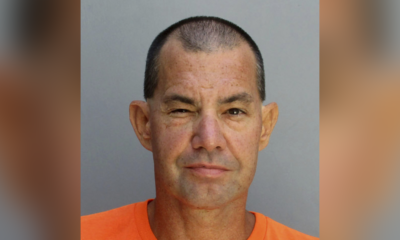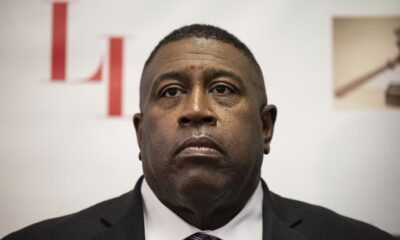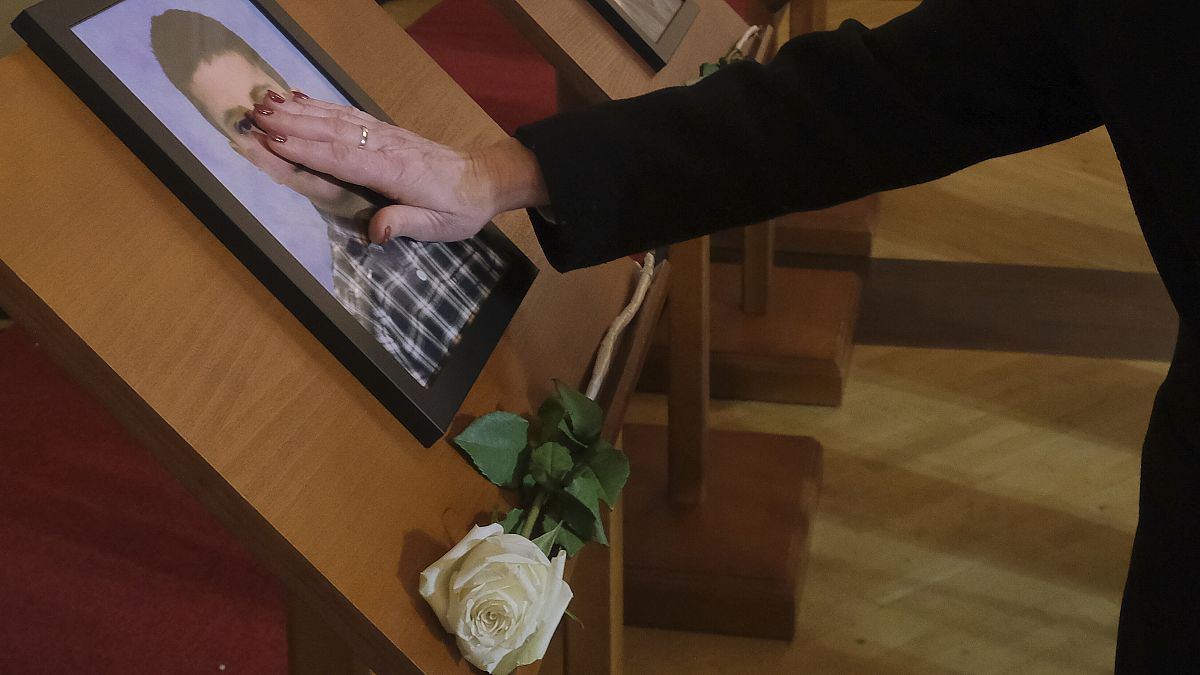Politics
Newsom aims to limit unhealthy food in California, getting ahead of Trump administration and RFK Jr.
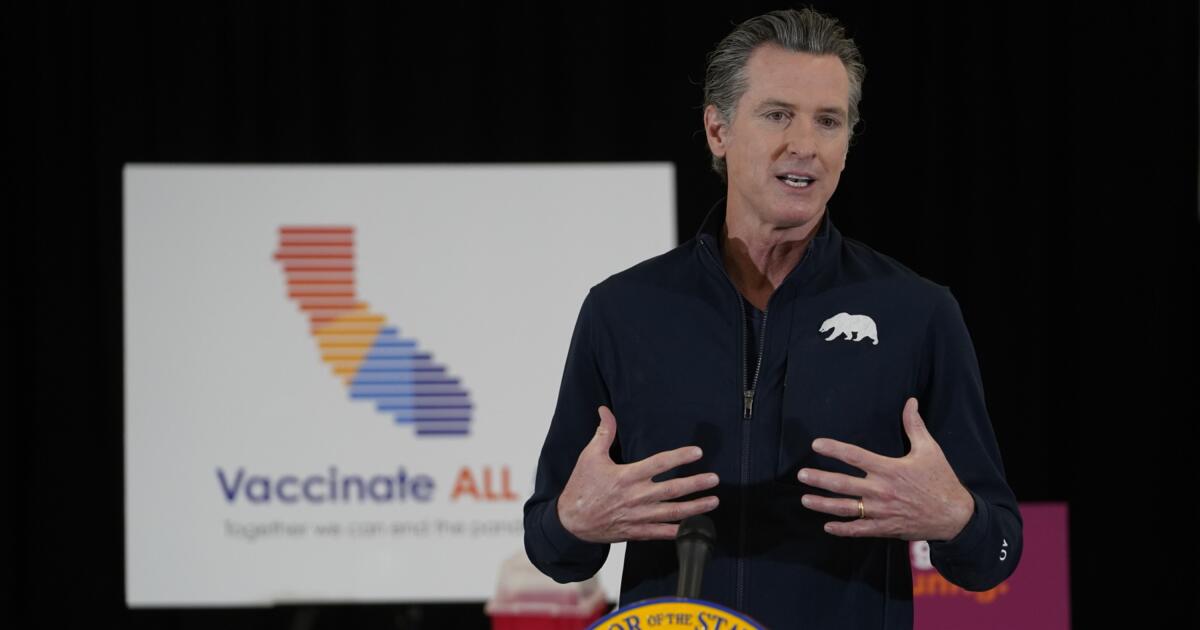
Gov. Gavin Newsom issued an executive order on Friday attempting to limit access to ultra-processed foods, a directive he cast as a continuation of California’s “nation leading” nutrition and health standards.
“The food we eat shouldn’t make us sick with disease or lead to lifelong consequences,” Newsom said in a statement. “California has been a leader for years in creating healthy and delicious school meals, and removing harmful ingredients and chemicals from food. We’re going to work with the industry, consumers and experts to crack down on ultra-processed foods, and create a healthier future for every Californian.”
The order directs state agencies to develop recommendations to limit the health harms of ultra-processed foods and calls for proposals to reduce the purchase of candy, soda and other unhealthy foods made with synthetic dyes or additives by recipients of government food benefits.
The move comes weeks before President-elect Donald Trump is sworn into office for his second term, with iconoclastic former environmental lawyer Robert F. Kennedy Jr. as his nominee for secretary of Health and Human Services. Kennedy still needs to be confirmed by the Senate, but he has been a vocal critic of ultra-processed foods and promised to radically overhaul the country’s food system. Food dyes, pasteurized milk and seed oils are among the common items he has criticized, sometimes making health claims that are not backed up by science.
Though Newsom didn’t mention Kennedy, the Democratic governor of California is planting a preemptive flag around the issue and signaling his refusal to concede the terrain to the incoming Trump administration. His executive order included a long list of steps the state has taken to improve nutrition.
Processed foods are foods altered from their natural form, like frozen vegetables, whereas ultra — or highly —processed foods are foods that have been significantly altered from their natural state, like packaged chips or soft drinks. Ultra-processed foods make up the vast majority of the U.S. food supply, research shows.
The Golden State has indeed been a national leader in banning food additives, with Newsom signing a 2023 bill that made California the first state in the nation to prohibit four additives found in popular cereal, soda, candy and drinks.
The California Food Safety Act was colloquially referred to as the “Skittles ban” before its passage because an earlier version of the bill also targeted titanium dioxide, which is used to color Skittles and several other popular candies. But the final law was amended to remove reference to the substance, solely banning brominated vegetable oil, potassium bromate, propylparaben and red dye No. 3.
Last year, Newsom signed a separate bill into law that bars snack foods containing a number of synthetic food dyes from California public schools. That law will prevent popular snack foods like Flamin’ Hot Cheetos from being stocked in school vending machines or cafeterias when it goes into effect on Dec. 31, 2027.
Laws to protect students from sugary drinks go back decades: In 2009 California banned all K-12 schools from offering soda.
The governor’s order cites the link between “ultra-processed foods” and cancer, obesity, diabetes and other health problems. The order says the U.S. allows more than 10,000 chemicals in food, color additives, or ingredients, compared to 300 that are allowed in the European Union.
Newsom is requiring the California Department of Public Health to provide recommendations by April 1 to limit the harms associated with ultra-processed foods and food ingredients that pose a health risk, which may include warning labels. He tasked the Californa Department of Social Services to issue recommendations to reduce the purchase by California food-stamp users of soda, candy, other ultra-processed foods, or foods made with synthetic food dye or additives on the same timeline.
Among several health directives, his order also requires state agencies to identify areas to increase standards for healthy school meals and to investigate the negative health consequences of food dyes.
Ultra-processed foods will likely be at the forefront of the national discourse in the coming weeks as Kennedy prepares for his Senate confirmation hearing.
Kennedy, a prominent anti-vaccine activist, has promoted a number of false health claims and fringe conspiracy theories. But his positions against food additives have also brought support from unlikely bedfellows who have criticized other parts of his “Make America Healthy Again” agenda.
“Yes, there are some things that he supports that we would agree with, but they feel more like the stopped clock that’s right twice a day,” Dr. Peter Lurie, president and executive director of the Center for Science in the Public Interest, said in an earlier interview with The Times — citing food additives as one example.
Lurie characterized Kennedy’s potential appointment more broadly as a dangerous choice because of his inability “to discern the difference between good and bad science.”
The Food and Drug Administration — the agency perhaps most publicly in Kennedy’s crosshairs — could be significantly impacted by his leadership if he is confirmed by the Senate.
The agency, which falls under the the Department of Health and Human Services, has a massive purview, regulating about 77% of the U.S. food supply and overseeing the safety of nearly $4 trillion worth of food, tobacco and medical products, according to federal data.

Politics
‘A Day of Love’: How Trump Inverted the Violent History of Jan. 6

In two weeks, Donald J. Trump is to emerge from an arched portal of the United States Capitol to once again take the presidential oath of office. As the Inauguration Day ritual conveying the peaceful transfer of power unfolds, he will stand where the worst of the mayhem of Jan. 6, 2021, took place, largely in his name.
Directly behind Mr. Trump will be the metal-and-glass doors where protesters, inflamed by his lie that the 2020 election had been stolen from him, stormed the Capitol with clubs, chemical irritants and other weapons. To his left, the spot where roaring rioters and outnumbered police officers fought hand to hand. To his right, where the prostrate body of a dying woman was jostled in the bloody fray.
And before him, a dozen marble steps descending to a lectern adorned with the presidential seal. The same steps where, four years earlier, Trump flags were waved above the frenzied crowd and wielded like spears; where an officer was dragged facedown to be beaten with an American flag on a pole and another was pulled into the scrum to be kicked and stomped.
In the wake of the attack on the Capitol, Mr. Trump’s volatile political career seemed over, his incendiary words before the riot rattling the leaders of his own Republican Party. Myriad factors explain his stunning resurrection, but not least of them is how effectively he and his loyalists have laundered the history of Jan. 6, turning a political nightmare into a political asset.
What began as a strained attempt to absolve Mr. Trump of responsibility for Jan. 6 gradually took hold, as his allies in Congress and the media played down the attack and redirected blame to left-wing plants, Democrats and even the government. Violent rioters — prosecuted, convicted and imprisoned — somehow became patriotic martyrs.
This inverted interpretation defied what the country had watched unfold, but it neatly fit the persecution narrative that binds Mr. Trump to many of his faithful. Once he committed to running again for president, he doubled down on flipping the script about the riot and its blowback, including a congressional inquiry and two criminal indictments against him, as part of an orchestrated victimization.
That day was an American calamity. Lawmakers huddled for safety. Vice President Mike Pence eluded a mob shouting that he should be hanged. Several people died during and after the riot, including one protester by gunshot and four police officers by suicide, and more than 140 officers were injured in a protracted melee that nearly upended what should have been the routine certification of the electoral victory of Mr. Trump’s opponent, Joseph R. Biden Jr.
But with his return to office, Mr. Trump now has the platform to further rinse and spin the Capitol attack into what he has called “a day of love.” He has vowed to pardon rioters in the first hour of his new administration, while his congressional supporters are pushing for criminal charges against those who investigated his actions on that chaotic day.
When asked about the reframing of the Capitol riot, and whether Mr. Trump accepts any responsibility for what unfolded on Jan. 6, his spokeswoman, Karoline Leavitt, instead referred in a statement to the “political losers” who tried to derail his career and asserted that “the mainstream media still refuses to report the truth about what happened that day.” She added, “The American people did not fall for the Left’s fear mongering over January 6th.”
The Jan. 6 tale that Mr. Trump tells is its own kind of replacement theory, one that covers over the marble-hard facts the way a blue carpet will cover those tainted Capitol steps on Inauguration Day.
The Seeds of Suspicion
What happened and why seemed beyond debate.
Hundreds of thousands of tips. Tens of thousands of hours of video footage. Thousands of seized cellphones. The attack on the Capitol was, after all, the largest digital crime scene in history, the total estimated cost of its aftermath exceeding $2.7 billion.
The Justice Department has experienced some setbacks in its criminal prosecutions — including a Supreme Court ruling that it overreached in using a controversial obstruction statute — but its success rate has been overwhelming. More than half of the nearly 1,600 defendants have pleaded guilty, while 200 more have been convicted after trial, resulting in sentences ranging from a few days in jail for misdemeanor trespassing to 22 years in prison for seditious conspiracy.
The story told by many of the indictments begins with a mixed-message speech delivered before the riot by Mr. Trump in a park near the White House. After falsely claiming that the 2020 election had been stolen, he encouraged people to march “peacefully and patriotically” to the Capitol, but reminded them that “we fight like hell.”
Mr. Trump retired to the White House, where he watched the televised violence and ignored advice to tell the mob to leave. Then, after sending two tweets calling for peaceful protest, he posted a video repeating his rigged-election falsehood and saying: “We have to have peace. So go home. We love you. You’re very special.”
A follow-up tweet ended: “Remember this day forever!”
Condemnation came swiftly. As shaken Republican leaders denounced him and Democrats moved to impeach him for “incitement of insurrection,” a seemingly chastened Mr. Trump called the riot “a heinous attack on the United States Capitol.” In those early days, he referred to Jan. 6 as “the calamity at the Capitol” and warned that lawbreakers “will pay.”
The outgoing president called for national unity but declined to attend his successor’s inauguration. The Republican-controlled Senate acquitted him of incitement, but its leader, Mitch McConnell, declared him “practically and morally responsible for provoking the events of the day” — a sentiment apparently shared by most Americans, with nearly 60 percent saying in polls that he should never hold office again.
But sand was already being thrown in the eyes of history.
Before the Capitol had even been secured, Representative Paul Gosar, Republican of Arizona, was asserting on Twitter that the events had “all the hallmarks of Antifa provocation.” Hours later, the Fox News commentator Laura Ingraham was telling viewers that “there are some reports that antifa sympathizers may have been sprinkled throughout the crowd.” And by morning, Representative Matt Gaetz, Republican of Florida, was claiming on the House floor that some rioters “were masquerading as Trump supporters and in fact were members of the violent terrorist group antifa.” (Mr. Gaetz would become President-elect Trump’s first choice for attorney general before being derailed by scandal.)
According to M.I.T. Technology Review, this fabrication was repeated online more than 400,000 times in the 24 hours after the Capitol attack, amplified by a cast of MAGA influencers, Republican officials and members of Mr. Trump’s family.
The former president remained mostly silent in the weeks that followed. But in a late March interview with Washington Post reporters that was not made public until months later, he provided an early hint of how he would frame the Jan. 6 attack.
The day he had previously called calamitous was now largely peaceful. The mob that stormed the Capitol had been “ushered in” by the police. And those who had rallied with him beforehand were a “loving crowd.”
A Deep-State Conspiracy Theory
Through the spring and summer of 2021, Mr. Trump’s Republican allies sought to sow doubt and blame others. It was as if Mr. McConnell, among other leading Republicans, had never publicly declared Mr. Trump responsible. As if the world had not seen what it had seen.
In early May, on the same day House Republicans stripped Representative Liz Cheney of Wyoming of her leadership role for labeling Mr. Trump a threat to democracy, they used an Oversight Committee hearing to minimize the riot. Representative Ralph Norman of South Carolina questioned whether all those rioters wearing Trump gear and shouting pro-Trump chants were truly Trump supporters, while Representative Andrew Clyde of Georgia likened much of the trespassing to a “normal tourist visit.”
This benign interpretation of Jan. 6 gave way to a much more startling theory, posed in mid-June by the Fox News host Tucker Carlson, at the time perhaps the most-watched commentator in cable news: The riot had been a false-flag operation orchestrated by the Federal Bureau of Investigation.
Mr. Gaetz and another Republican loyalist, Representative Marjorie Taylor Greene of Georgia, quickly seconded the deep-state conspiracy theory, while Mr. Gosar entered the article on which it was based — written by Darren Beattie, a former Trump speechwriter who had been fired for speaking at a conference beside white supremacists — into the Congressional Record.
Soon after, Mr. Trump broke his monthslong silence about Jan. 6. At an early July rally in Sarasota, Fla., he invoked the name of Ashli Babbitt, a pro-Trump rioter who had been fatally shot by a Capitol police officer while trying to breach the House floor, where lawmakers and staff members had sought safety. She was fast becoming a martyr to the cause.
“Shot, boom,” Mr. Trump said. “There was no reason for it. Who shot Ashli Babbitt?”
The former president also referred to the jailed rioters. Floating the specter of a justice system prejudiced against conservatives, he questioned why “so many people are still in jail over Jan. 6” when antifa and Black Lives Matter hadn’t paid a price for the violent protests that followed the murder of a Black man, George Floyd, by a white Minneapolis police officer in 2020.
The fog machine of conspiracy was turned up a few notches that fall, when the Fox Nation streaming service released “Patriot Purge,” a three-part series in which Mr. Carlson expanded on his specious contention that the Capitol attack was a government plot to discredit Mr. Trump and persecute conservatives.
The widely denounced claim was deemed so outrageous that two Fox News contributors, Jonah Goldberg and Stephen Hayes, resigned in protest. In a scathing blog post, they wrote that the program was a hodgepodge of “factual inaccuracies, half-truths, deceptive imagery and damning omissions.”
Mr. Carlson’s documentary, they wrote, “creates an alternative history of January 6, contradicted not just by common sense, not just by the testimony and on-the-record statements of many participants, but by the reporting of the news division of Fox News itself.”
Martyrs and Vigils
Amid the conspiratorial swirl of antifa agitators and deep-state plots, a related narrative was gaining traction: the glorification of those who had attacked the Capitol. Instead of marauders, vandals and aggressors, they were now political prisoners, hostages, martyrs. Patriots.
This movement’s energy radiated from a troubled detention center in Washington where a few dozen men charged with attacking police officers and committing other violent offenses were held. A defiant esprit de corps developed among them in the so-called Patriot Wing, where inmates in prison-issue orange gathered every night to sing the national anthem.
Outside the razor-wire walls, their supporters kept vigil in a spot dubbed the “Freedom Corner.” Led by Ms. Babbitt’s mother, among others, they set out snacks, flew American flags and live-streamed phone conversations with inmates.
Sympathy that might have been reserved for the injured police officers was directed instead to those who had assaulted them. And Mr. Trump — whose Jan. 6 actions were now being investigated by the Justice Department and a bipartisan House select committee — emerged in 2022 as their No. 1 sympathizer.
At a mid-January rally in Florence, Ariz., he described the Jan. 6 defendants as persecuted political prisoners. Later that month, in Conroe, Texas, he promised that if he was re-elected, and if pardons were required, “we will give them pardons because they are being treated so unfairly.”
Mr. Trump’s counteroffensive began taking shape. The House select committee, whose members included Ms. Cheney, became in his words the “unselect committee” and the prevailing narrative of Jan. 6 as an insurrection “a lot of crap.”
One of his most repeated contentions was that the Democratic House speaker, Nancy Pelosi, had rejected his recommendation to have 10,000 soldiers present on Jan. 6. But subsequent investigations demonstrated that it was his own military advisers, and not Ms. Pelosi, who blocked the idea, concerned with both the optics of armed soldiers at a political protest and the possibility that Mr. Trump might invoke the Insurrection Act to place the troops under his direct command.
“There is absolutely no way I was putting U.S. military forces at the Capitol,” the acting defense secretary, Christopher Miller, later told investigators. Doing so, he said, could have created “the greatest constitutional crisis probably since the Civil War.”
As the select committee began holding hearings in early June 2022, Mr. Trump used speeches and his social media platform, Truth Social, to clap back at the damaging evidence and testimony. One post read: “The so-called ‘Rush on the Capitol’ was not caused by me, it was caused by a Rigged and Stolen Election!”
In a speech in Nashville that month, he dismissed the riot as a “simple protest” that “got out of hand,” again floated the possibility of pardons and furthered the false-flag theory by mentioning Ray Epps, a protester falsely portrayed by Mr. Carlson on Fox News and Republicans in Congress as a government plant who had stage-managed the riot.
His efforts seemed to be working. By mid-2022, an NBC News poll found that fewer than half of Americans still considered Mr. Trump “solely” or “mainly” responsible for Jan. 6.
For some supporters, though, Mr. Trump was not doing enough. In the late summer, he agreed to meet two advocates for the Jan. 6 defendants at his golf club in Bedminster, N.J.: Julie Kelly, a conservative journalist who had written skeptically about the Capitol attack, and Cynthia Hughes, a founder of the Patriot Freedom Project, which supported the inmates’ families. Ms. Hughes was also an aunt of Timothy Hale-Cusanelli, a professed Hitler fanboy who had spent time in the Patriot Wing.
They told Mr. Trump that the defendants and their families felt abandoned by him, Ms. Kelly later recalled, and that some of the federal judges in Washington he had appointed were among the worst in their handling of Jan. 6 cases.
These jurists had earned the ire of people like Ms. Kelly by repeatedly rejecting arguments that the defendants could not get fair trials in liberal Washington or had been unduly prosecuted for their pro-Trump politics. The judges also knocked down the contention that nonviolent rioters should not have been charged at all, ruling that everyone in the mob, “no matter how modestly behaved,” contributed to the chaos at the Capitol.
After his meeting with the women, Mr. Trump donated $10,000 to Ms. Hughes’s organization and told a conservative radio host that if he was elected, there would be full pardons and “an apology to many.” Days later, Ms. Hughes was given a speaking role at a Trump rally in Wilkes-Barre, Pa.
Ms. Hughes’s Patriot Freedom Project closed out 2022 with a fund-raising holiday party at the Capitol Hill Hilton, in sight of the riot scene. Children received gifts, inmates spoke to the crowd from jail and tearful family members shared their hardships. There was also a surprise video message of encouragement from Mr. Trump, who had recently announced his candidacy.
Then, just before Christmas, the House select committee released its final report, based largely on testimony from those inside Mr. Trump’s orbit. It accused him of repeatedly lying about a stolen election and summoning the angry mob that thwarted a peaceful transition between administrations.
In the report’s foreword, Ms. Cheney recalled how her great-great-grandfather answered Abraham Lincoln’s call to defend the union by joining the 21st Ohio Volunteer Infantry. He fought for four years, she wrote, for the same essential principle the committee was empaneled to protect: the peaceful transfer of power.
The Candidate and the Prison Choir
Perhaps the moment when Mr. Trump and his allies fully embraced their alternate version of history came on March 3, 2023, when a new song appeared on major streaming platforms.
The song, “Justice for All,” featured Mr. Trump reciting the Pledge of Allegiance while the men of the Patriot Wing, now billing themselves as the J6 Prison Choir, sang the national anthem. In other words, it was a collaboration between a man seeking the Republican presidential nomination and about 20 men charged with attacking the nerve center of the republic.
Mr. Trump recorded his contribution at his Mar-a-Lago residence in Florida, while the choir was recorded with a phone in the Washington jail. The song — a fund-raising effort that the Trump loyalist Kash Patel, now the president-elect’s nominee to head the F.B.I., helped produce — concludes with a defiant echo of the “U.S.A.!” chants that resounded during the Jan. 6 attack.
The first Trump campaign rally for the 2024 election took place three weeks later, in Waco, Texas, where a deadly standoff between federal agents and a religious cult in 1993 became a far-right touchstone. Before launching into complaints about persecution and promises of retribution, the candidate placed his hand over his heart for the playing of what an announcer called “the No. 1 song” on iTunes and Amazon, featuring Mr. Trump “and the J6 Choir.”
Mr. Trump’s version of the attack on the Capitol had firmly taken hold, at least within his party. A YouGov poll at the time found that most Republicans believed the events of Jan. 6 reflected “legitimate political discourse.”
In August 2023, Mr. Trump was indicted twice on charges of interfering with the 2020 election results: at the state level, for illegally seeking to overturn the results of the election in Georgia, which he had narrowly lost; and at the federal level, for conspiring to impede the Jan. 6 certification of Mr. Biden’s election.
A subsequent court filing by Jack Smith, the special counsel leading the federal investigation, cited Mr. Trump’s steadfast endorsement of the rioters and of the prison choir, “many of whose criminal history and/or crimes on January 6 were so violent that their pretrial release would pose a danger to the public.” The former president, it continued, “has financially supported and celebrated these offenders — many of whom assaulted law enforcement on January 6 — by promoting and playing their recording of the national anthem at political rallies and calling them ‘hostages.’”
All true. Still, Mr. Trump continued to play “Justice for All” at rallies and at Mar-a-Lago, spread his rigged-election lie, drop intimations of false-flag conspiracies, refer to those who stormed the Capitol as patriots — and, now, transformed the indictments into further fuel for his persecution narrative.
In so many ways, Jan. 6 had become part of his brand — a brand in which an attack on the symbol of American democracy became a defense of that same democracy: a blow against political thugs and closet communists, deep-state plots and an unjust justice system.
A part of the brand that, in November, helped Mr. Trump win election as the 47th president of the United States.
Promising Pardons — and Payback
Once he takes office, Mr. Trump will be positioned to finish refashioning Jan. 6 as a modern Lost Cause of the Confederacy.
With the help of Republican loyalists, the Senate acquitted him of incitement at his impeachment trial. The Supreme Court he had helped mold rejected an attempt to keep him off the ballot under a constitutional ban against insurrectionists from holding office. And his legal maneuvering — to delay, delay, delay — succeeded: In the days after the election, Mr. Smith, the special counsel, dropped his election-subversion case, adhering to a Justice Department policy not to prosecute a sitting president.
An emboldened Mr. Trump has already indicated that his presidential agenda will include payback for those who declared him responsible for the Capitol attack. He has said that Mr. Smith “should be thrown out of the country,” and that Ms. Cheney and other leaders of the House select committee — “one of the greatest political scams in history,” his spokeswoman, Ms. Leavitt, said — should “go to jail,” without providing evidence to warrant such extreme measures.
At the same time, Mr. Trump’s repeated vows to pardon those implicated in the Capitol riot, an act of erasure that would validate their claims of political persecution, has electrified the Jan. 6 community of families, defendants and felons. On election night, those keeping vigil outside the Washington jail celebrated with champagne.
Even though Mr. Trump has not specified whom he would pardon, many Jan. 6 participants are anticipating a general amnesty for everyone involved. One defendant, charged with attacking police officers with a baseball bat, even promoted an A.I. video of inmates in orange jumpsuits parading triumphantly out of jailhouse doors.
Many defendants have requested delays in their court proceedings because, they say, the imminent pardons will render their cases moot. Among those employing this argument was Philip Sean Grillo, convicted of several misdemeanors after entering the Capitol through a broken window and later boasting in a recording that “we stormed the Capitol. We shut it down! We did it!”
But to Mr. Grillo’s misfortune, the federal judge handling his case was Royce C. Lamberth, 81, a no-nonsense former prosecutor who had been appointed by President Ronald Reagan in 1987. Judge Lamberth not only rejected Mr. Grillo’s request for a delay, he filed a court document to “clear the air” and “remind ourselves what really happened.”
With clinical precision, the judge recalled how an angry mob invaded and occupied the Capitol with intentions to “thwart the peaceful transfer of power that is the centerpiece of our Constitution and the cornerstone of our republican legacy”; how they ignored directives to turn back and desist; how some engaged in “pitched battle” with the police, “stampeding through and over the officers.”
“They told the world that the election was stolen, a claim for which no evidence has ever emerged,” the judge wrote. “They told the world that they were there to put a stop to the transfer of power, even if that meant ransacking, emptying, and desecrating our country’s most hallowed sites. Most disturbingly, they told the world that particular elected officials who were present at the Capitol that day had to be removed, hurt, or even killed.”
The country came “perilously close” to letting the orderly transfer of power slip away, Judge Lamberth wrote. He knew this, he said, because he and his colleagues had presided over hundreds of trials, read hundreds of guilty pleas, heard from hundreds of law enforcement witnesses — “and viewed thousands of hours of video footage attesting to the bedlam.”
With that, Judge Lamberth ordered Mr. Grillo to be taken immediately into custody to begin a sentence of one year in prison.
As he was being handcuffed, the Jan. 6 rioter taunted the veteran judge by saying it didn’t matter: He would be pardoned anyway — by a man who will soon benefit from the peaceful transfer of power while standing on a blue carpet covering an old crime scene.
Dylan Freedman contributed reporting.
Politics
Trump names latest White House staff picks as Jan. 20 inauguration approaches
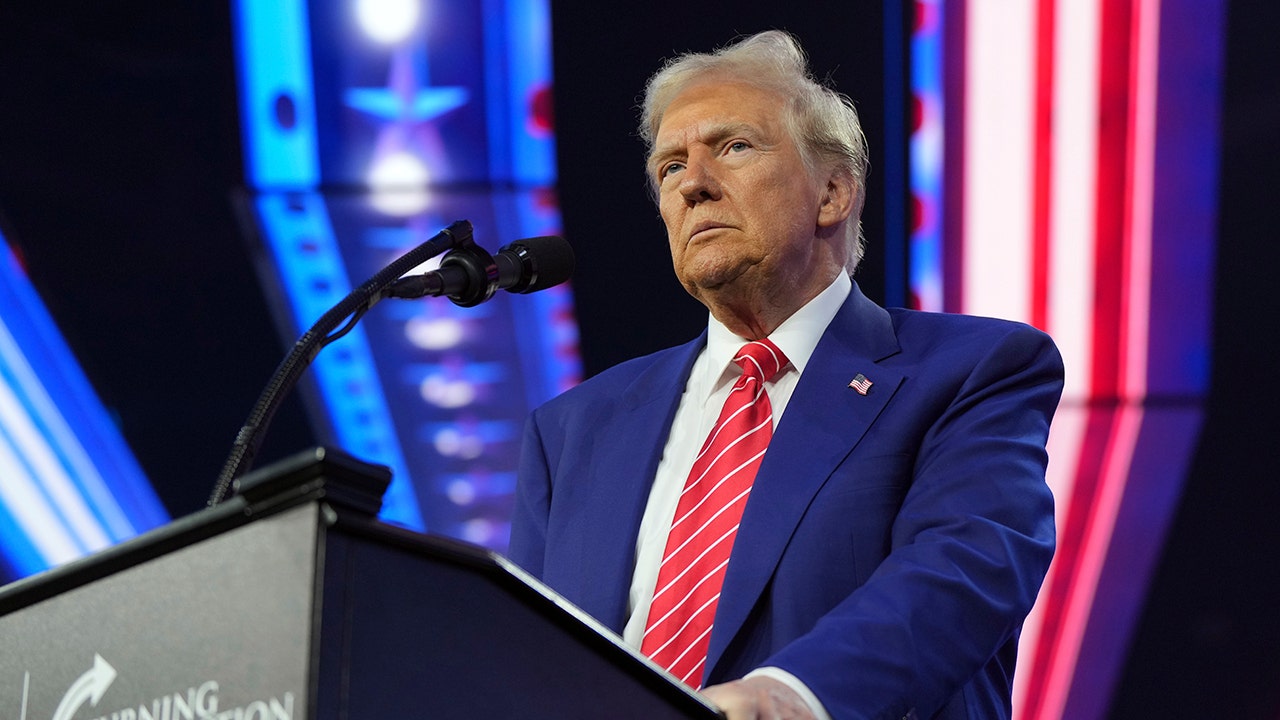
President-elect Trump announced his latest staff picks on Saturday night, naming four additional people to serve in the White House in administrative and advisory capacities.
Trump, who takes office in less than three weeks, began by naming Stanley E. Woodward, Jr., to serve as an assistant to the president and a senior counselor.
Woodward co-founded a law firm called Brand Woodward Law, LP, where he “represented numerous high-profile clients in complex, high-stakes litigation, including multiple federal jury trials,” according to Trump.
“Previously, he worked at a multinational law firm where his experience included the representation of multiple international corporations in defense of alleged violations of the U.S. Foreign Corrupt Practices Act as well as serving as coordinating counsel to companies involved in nationwide federal litigation,” the statement read.
AMB. CARLA SANDS: TRUMP ADMINISTRATION’S FOCUS ON GREENLAND–WHY WE HOPE TO STRENGTHEN OUR RELATIONSHIP
President-elect Donald Trump speaks at AmericaFest, Sunday, Dec. 22, 2024, in Phoenix. (AP Photo/Rick Scuteri)
Next, Trump said that Robert Gabriel, Jr., will work as an assistant to the president for policy.
“Mr. Gabriel has served President Donald J. Trump in various roles since his 2015 campaign for the world’s most powerful office,” the statement read. He started in Trump Tower as a Policy Advisor on Mr. Trump’s historic campaign.”
“Mr. Gabriel served in the West Wing, for the entirety of the first Trump Administration, as Special Assistant to the President.”
Nicholas F. Luna is slated to serve as assistant to the president and deputy chief of staff for strategic implementation, the president-elect said. His role will involve scheduling and managing external White House communications.
JEAN-PIERRE BRISTLES WHEN PRESSED ON PAST ‘DEMOCRACY’ WARNINGS: ‘DO NOT APPRECIATE HAVING MY WORDS TWISTED’

Attorney Stanley Woodward leaves the Alto Lee Adams Sr. U.S. Courthouse in Fort Pierce, Fla. (Joe Raedle/Getty Images)
Trump called Luna a “highly respected White House veteran and a Trump-Vance campaign warrior.”
“He previously served in the White House as Presidential Trip Director, Personal Aide to the President, Assistant to the President, and Director of Oval Office Operations,” Trump said. “Most recently, he served with great distinction as Director of Operations for Vice President-elect JD Vance.”

Nicholas Luna looks on during a roundtable in the State Dining Room of the White House in 2020. (Doug Mills/Pool/Getty Images)
Finally, Trump said that William “Beau” Harrison will serve as an assistant to the president and deputy chief of staff for operations. The statement called him a “trusted aide to the President and First Family.”
“During President Trump’s first term, Mr. Harrison served as the liaison between the operational elements of the Executive Office of the President and was charged with the coordination and execution of all presidential travel, including dozens of complex international visits,” Trump’s statement added. “He has participated in and led multiple U.S. delegations across the globe in countries, such as North Korea, Iraq, and Afghanistan, and played a critical role in planning each of the historic summits with DPRK Leader Kim Jong-Un.”
Politics
Federal court decision won't change California net neutrality law
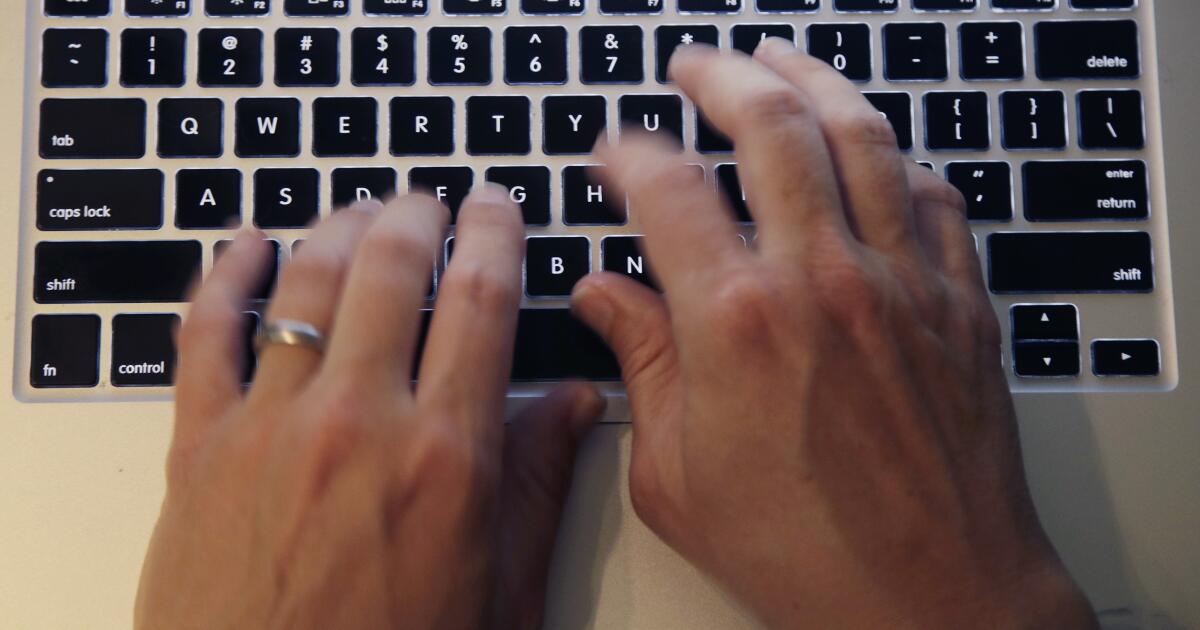
Despite the dismantling of the Federal Communications Commission’s efforts to regulate broadband internet service, state laws in California, New York and elsewhere remain intact.
This week’s decision by the 6th U.S. Circuit Court of Appeals, striking down the FCC’s open internet rules, has little bearing on state laws enacted during the years-long tug-of-war over the government’s power to regulate internet service providers, telecommunications experts said.
In fact, some suggested that the Cincinnati-based 6th Circuit’s decision — along with other rulings and the U.S. Supreme Court’s posture on a separate New York case — has effectively fortified state regulators’ efforts to fill the gap.
“Absent an act of Congress, the FCC has virtually no role in broadband any more,” Ernesto Falcon, a program manager for the California Public Utilities Commission, said in an interview. “The result of this decision is that states like California, New York and others will have to govern and regulate broadband carriers on our own.”
California has one of the nation’s strongest laws on net neutrality, the principle that internet traffic must be treated equally to ensure a free and open network. Former Gov. Jerry Brown signed the measure into law in 2018, months after federal regulators in President elect-Donald Trump’s first administration repealed the net neutrality rules put in place under President Obama.
Colorado, Oregon and other states also adopted their own standards.
The Golden State’s law has already survived legal challenges. It also prompted changes in the way internet service providers offered plans and services.
“California’s net neutrality law, which is seen as the gold standard by consumer advocates, carries national impact,” Falcon said.
Known as the California Internet Consumer Protection and Net Neutrality Act (formerly California Senate Bill 822), the law blocks what the state views as anti-competitive practices that harm consumers.
Such measures include slowing or throttling traffic speeds by internet providers. It also bans some forms of “zero rating,” an industry term for when a company exempts a select service from data caps.
After California’s law went into effect, telecommunications giant AT&T ended its practice of providing the Max streaming service to its phone customers without counting usage against a customer’s data cap. Streams of other services — those not owned by AT&T — were counted against the cap. The practice was seen as a way to keep consumers tethered to their AT&T phones.
The first Trump administration sued to block California’s law, delaying it for several years.
But after President Biden took office in 2021, his administration dropped efforts to defang California’s law.
An industry trade group, representing broadband providers, took up the cause. The group, ACA Connects, sued California Atty. Gen. Rob Bonta, seeking a preliminary injunction to prevent the law from taking effect.
But the courts turned back that legal effort, and the California-based 9th U.S. Circuit Court of Appeals upheld the state law three years ago.
“The state laws have all been upheld,” said John Bergmayer, legal director of the pro-open internet consumer advocacy group Public Knowledge.
Last April, the FCC sought to reinstate the Obama-era rules to provide a national standard.
The FCC was seeking increased oversight so it could step in to force internet providers respond to service outages or security breaches. The FCC also cited national security interests, saying greater scrutiny was needed to enable the commission to effectively crack down on foreign-owned companies deemed security threats.
But three 6th Circuit judges ruled unanimously on Thursday that the FCC went beyond its authority when it tried to reclassify broadband service as a “telecommunications” service that was subjected to increased federal regulation under the 1934 Communications Act and the 1996 Telecommunications Act.
The ruling did not address state net neutrality laws.
Blair Levin, a former top FCC official and policy advisor to New Street Research, said the “the new decision keeps open the door to state action.”
In addition, Levin said the 9th Circuit determined that FCC measures did not preempt states from separately taking action.
He and other legal experts also pointed out the U.S. Supreme Court’s refusal to hear a challenge to a New York law that requires internet service providers to offer low-income broadband service at a speed and price set by the state.
Because the high court skipped that case, the New York law stands. That could invite additional state actions, the analysts said.
“The state’s authority and role in broadband access has grown dramatically now,” Falcon said.
-

 Health1 week ago
Health1 week agoNew Year life lessons from country star: 'Never forget where you came from'
-
/cdn.vox-cdn.com/uploads/chorus_asset/file/24982514/Quest_3_dock.jpg)
/cdn.vox-cdn.com/uploads/chorus_asset/file/24982514/Quest_3_dock.jpg) Technology1 week ago
Technology1 week agoMeta’s ‘software update issue’ has been breaking Quest headsets for weeks
-

 Business4 days ago
Business4 days agoThese are the top 7 issues facing the struggling restaurant industry in 2025
-

 Politics1 week ago
Politics1 week ago'Politics is bad for business.' Why Disney's Bob Iger is trying to avoid hot buttons
-

 Culture4 days ago
Culture4 days agoThe 25 worst losses in college football history, including Baylor’s 2024 entry at Colorado
-

 Sports4 days ago
Sports4 days agoThe top out-of-contract players available as free transfers: Kimmich, De Bruyne, Van Dijk…
-

 Politics3 days ago
Politics3 days agoNew Orleans attacker had 'remote detonator' for explosives in French Quarter, Biden says
-

 Politics2 days ago
Politics2 days agoCarter's judicial picks reshaped the federal bench across the country



